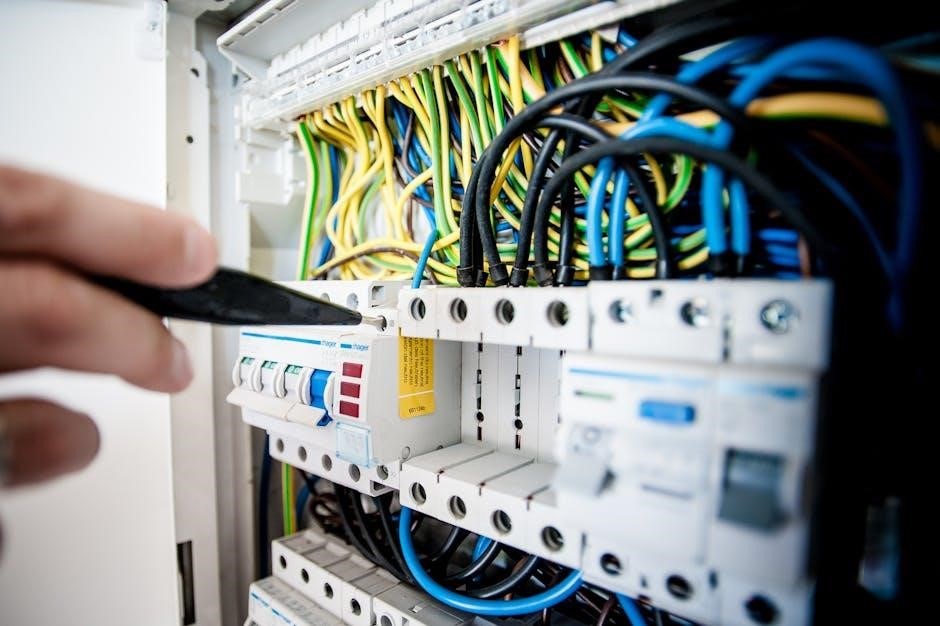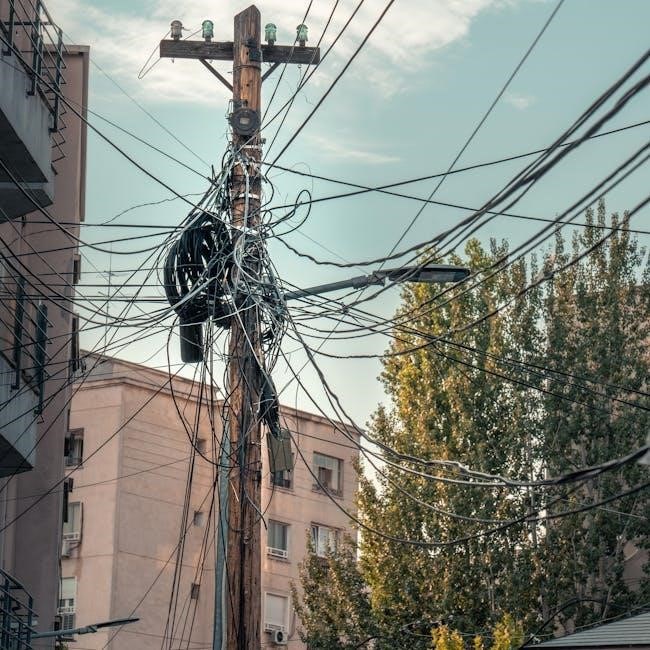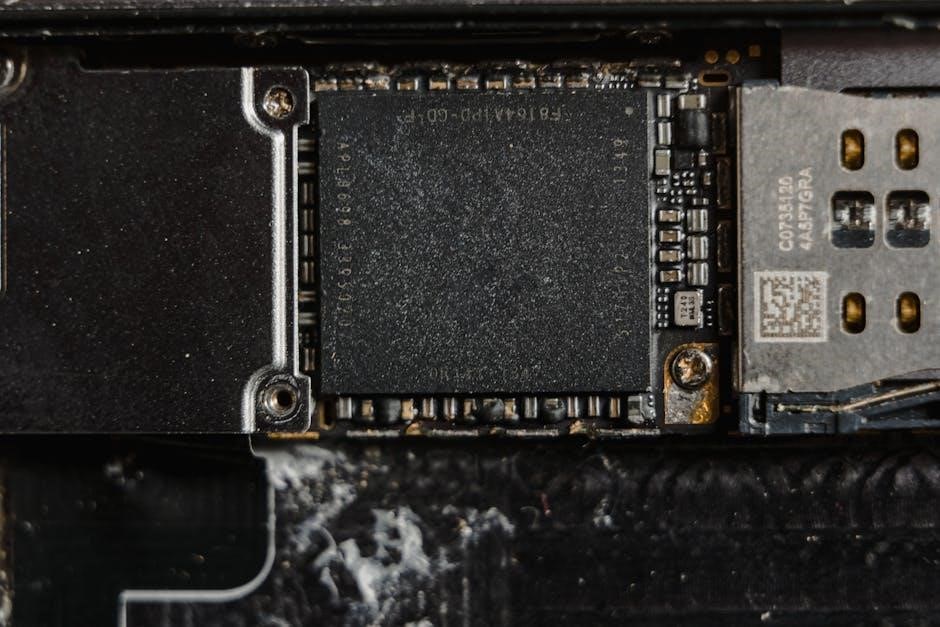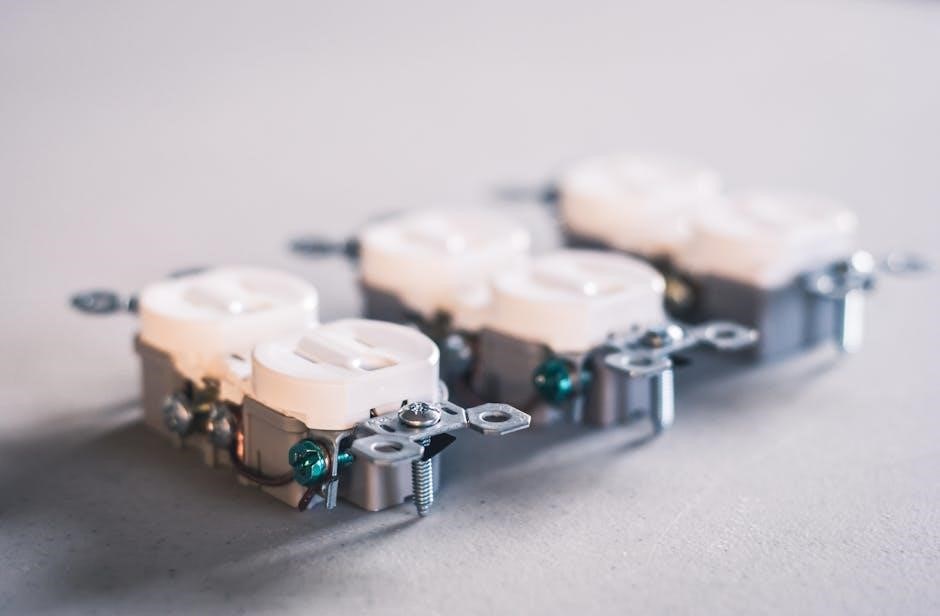Electric scooter wiring diagrams are essential for understanding and repairing electrical systems․ They provide a visual roadmap of connections, circuits, and components, ensuring safe and efficient troubleshooting and modifications․
1․1 Importance of Wiring Diagrams for Electric Scooters
Wiring diagrams are crucial for understanding and working with electric scooter electrical systems․ They provide a clear visual representation of connections, circuits, and components, making it easier to identify and resolve issues․ These diagrams are essential for safety, as they help prevent short circuits and incorrect wiring that could lead to electrical fires or system failures․ Whether troubleshooting, repairing, or customizing, a wiring diagram ensures accurate and efficient work․ It also serves as a guide for DIY enthusiasts and professionals, helping them understand how components like motors, batteries, and controllers interact․ By following a wiring diagram, users can ensure compliance with safety standards and maintain their scooter’s performance and reliability․
1․2 Brief Overview of Electric Scooter Components
Electric scooters consist of several key components that work together to provide power and functionality․ The motor, typically a hub or brushless type, drives the scooter․ The controller acts as the brain, regulating power flow between the battery and motor․ The battery, often lithium-based, stores energy and determines range․ Throttle and brake systems control speed and stopping․ Wiring connects these components, enabling communication and power distribution․ Sensors, such as Hall effect sensors, monitor motor operation․ Fuses and relays protect against overcurrent and manage electrical loads․ understanding these components and their connections is vital for effective troubleshooting and customization, as detailed in wiring diagrams․

Understanding Electric Scooter Wiring Components
Electric scooter wiring involves motors, controllers, batteries, throttles, and sensors․ These components are connected through wires, fuses, and relays, ensuring power flows safely and efficiently․
2․1 Motor and Controller Wiring
The motor and controller are central to an electric scooter’s operation․ The controller regulates power from the battery to the motor, ensuring efficient speed and torque control․ Wiring between these components must be precise to avoid short circuits or overheating․ Diagrams often show three-phase motor wires connected to the controller, with hall sensors ensuring proper commutation․ Proper insulation and secure connections are crucial for reliability․ Always refer to manufacturer-specific diagrams for accurate wiring configurations, as variations exist between models․ Improper wiring can lead to reduced performance or safety hazards, making it essential to follow established guidelines․
2․2 Battery and Charging System Connections
The battery and charging system are critical for powering an electric scooter․ Wiring diagrams detail connections between the battery management system (BMS), battery pack, and charger․ The BMS ensures safe voltage and temperature levels, while the charger replenishes the battery without overcharging․ Proper wiring connects the positive and negative terminals to the controller and motor, ensuring efficient power flow․ High-current connectors are used to minimize resistance․ Always follow the diagram to avoid short circuits or improper connections, which can damage components․ Regular inspection of these wires is essential for safety and performance․ Correct wiring ensures reliable energy supply, extending the scooter’s range and lifespan․ Always refer to manufacturer-specific diagrams for accurate configurations․

Types of Electric Scooter Wiring Diagrams
Electric scooter wiring diagrams are categorized into basic and advanced schematics․ Basic diagrams simplify DIY repairs, while advanced diagrams cater to custom modifications, ensuring clarity and safety in all configurations․
3․1 Basic Wiring Schematics for DIY Repairs
Basic wiring schematics for electric scooters are designed to simplify DIY repairs․ These diagrams provide a clear, concise visual representation of essential connections, including the motor, controller, battery, and throttle․ They often use color-coded lines to differentiate between positive and negative terminals, making it easier to identify and trace wires․ By focusing on fundamental components, these schematics empower users to diagnose and fix common issues like faulty connections or blown fuses without advanced technical knowledge․ Additionally, many PDF resources offer step-by-step instructions alongside basic schematics, ensuring a user-friendly experience for those new to electrical systems․ Regular updates and compatibility with various scooter models further enhance their practicality for enthusiasts and novices alike․
3․2 Advanced Wiring Diagrams for Custom Modifications
Advanced wiring diagrams are tailored for enthusiasts and experts seeking to customize their electric scooters․ These detailed schematics often include complex setups, such as dual motor configurations, custom battery packs, and high-performance controllers․ They provide in-depth guidance for integrating aftermarket components, like upgraded throttles, regenerative braking systems, and advanced lighting setups․ Many PDF resources offer modular diagrams, allowing users to adapt and combine circuits for unique projects․ These diagrams are particularly useful for high-power mods, such as 60V or 72V systems, and dual-controller setups․ They also include troubleshooting tips for common issues that arise during customizations, ensuring a safer and more efficient modification process․ Advanced wiring diagrams are indispensable for those aiming to push their scooter’s performance to the next level․
Safety Precautions for Wiring Diagram Usage
Always disconnect the battery and wear protective gear when working with electrical systems․ Ensure tools are insulated, and avoid short circuits to prevent damage or injury․
4․1 Essential Safety Tips for Handling Electrical Systems
When working with electric scooter wiring, always disconnect the battery first to prevent accidental power-ups․ Use insulated tools to avoid electric shocks․ Ensure the scooter is on a stable, flat surface․ Wear protective gloves and eyewear․ Never attempt repairs near open flames or sparks․ Use a multimeter to test live wires cautiously․ Avoid touching electrical components with bare hands․ Keep loose clothing tied back to prevent entanglements․ Ensure good ventilation to avoid inhaling fumes from soldering․ Never override safety features like circuit breakers․ If unsure, consult a professional or the manufacturer’s guidelines․ Regularly inspect wires for damage before reconnecting․ Always follow the wiring diagram’s instructions precisely to maintain safety and functionality․
4․2 Common Mistakes to Avoid in Wiring Repairs
When repairing electric scooter wiring, avoid common mistakes like not disconnecting the battery, which can lead to electric shocks․ Using incorrect tools or wires can cause short circuits․ Overlooking the wiring diagram may result in improper connections․ Rushing repairs increases the risk of errors․ Ignoring insulation checks can lead to exposed wires and hazards․ Forgetting to test components before reassembly is another oversight․ Mixing up motor and battery wires is a frequent issue․ Using incompatible connectors can cause poor connections․ Neglecting to secure wires properly can lead to damage․ Overlooking fuse replacements can risk system overloads․ Always double-check connections and consult the diagram to ensure accuracy and safety during repairs․

Reading and Interpreting Wiring Diagrams
Electric scooter wiring diagrams use symbols and color codes to represent components․ Understanding these elements is crucial for tracing circuits and ensuring proper connections, enhancing safety and functionality․
5․1 Understanding Symbols and Notations
Electric scooter wiring diagrams rely on standardized symbols to represent components like motors, controllers, and batteries․ Notations such as “V+” for positive voltage and “GND” for ground are common․ These symbols simplify complex circuits, making it easier to identify connections and troubleshoot issues․ For example, a battery is often shown as two parallel lines, while a motor is depicted as a coil․ Understanding these notations is essential for accurately interpreting the diagram and ensuring safe repairs․ Consistency in symbols across diagrams helps users apply knowledge to various scooter models, making the process more intuitive and efficient for DIY enthusiasts and professionals alike․
5․2 Color Codes and Their Significance
In electric scooter wiring diagrams, color codes play a crucial role in identifying wire functions․ Red typically signifies positive voltage, while black represents ground or negative connections․ Yellow often denotes throttle or signal wires, and green may indicate brake or safety circuits․ These color standards help technicians and DIY enthusiasts quickly trace connections and diagnose issues․ Consistent color coding reduces the risk of short circuits or faulty repairs․ For example, a red wire should never be connected to a black wire without proper understanding, as this could lead to system damage․ Recognizing these color codes ensures safe and efficient troubleshooting, making them indispensable for anyone working with scooter electrical systems․

Step-by-Step Guide to Wiring an Electric Scooter
Start by connecting the motor to the controller, ensuring proper alignment of phase wires․ Next, link the battery to the controller and integrate the throttle system for power delivery․
6․1 Connecting the Motor to the Controller
Connecting the motor to the controller is a critical step in wiring an electric scooter․ Begin by identifying the phase wires from the motor and matching them to the controller’s corresponding terminals․ Ensure the hall sensor wires are securely connected to the controller’s sensor ports․ Refer to the wiring diagram to confirm the correct polarity and pin assignments․ Tighten all connections firmly to avoid loose wires, which can cause electrical failures․ After connecting, perform a preliminary test by powering on the system without throttle input to verify proper operation․ Always disconnect the battery before making or breaking connections to prevent short circuits or damage to components․
6․2 Integrating the Battery and Throttle System
Integrating the battery and throttle system requires careful attention to detail․ Start by connecting the positive and negative terminals of the battery to the controller, ensuring correct polarity․ Next, attach the throttle connector to the controller’s designated input port․ Use the wiring diagram to verify the throttle’s signal and power wires are correctly aligned․ Secure all connections with heat shrink or electrical tape to prevent corrosion and wear․ Finally, test the throttle by gradually increasing the input to ensure smooth motor response․ Always charge the battery to the recommended level before testing and avoid over-discharging to maintain its lifespan․ Proper integration ensures efficient power delivery and responsive control for a safe and enjoyable ride․

Troubleshooting Common Wiring Issues
Identify short circuits, faulty connections, or loose wires using a multimeter․ Test battery voltage and ensure proper connections between components․ Check for worn insulation or corrosion that may cause intermittent operation․
7․1 Identifying Short Circuits and Faulty Connections
Locate short circuits by inspecting wires for visible damage or melted insulation․ Use a multimeter to measure resistance between wires․ Unusual readings indicate a short․ Check connectors for corrosion or loose connections, which can disrupt power flow․ Ensure all terminals are secure and free from debris․ Refer to your wiring diagram to trace circuits systematically․ Power off the scooter before testing to avoid electrical shocks․ If a short is found, isolate the affected area and repair or replace the damaged component․ Regular inspections can prevent such issues, ensuring reliable scooter performance and safety․
7․2 Diagnosing Power Supply Problems
Diagnose power supply issues by checking the battery voltage with a multimeter․ Compare readings to the specified voltage in the wiring diagram․ Inspect battery terminals for corrosion or loose connections․ Ensure the battery management system is functioning correctly․ Examine the wiring diagram to trace power supply routes․ Verify that fuses or circuit breakers are intact and not blown․ Test the throttle and controller connections for continuity․ If the scooter has no power, check the main power switch and wiring harness for damage․ Consult the wiring diagram to isolate the source of the problem, whether it’s a faulty battery, controller, or electrical connection․

Maintenance Tips for Electric Scooter Wiring
Regularly inspect wires and connectors for damage or corrosion․ Clean terminals and ensure secure connections․ Use protective sleeves to shield wires from abrasion and moisture exposure․

8․1 Regular Inspection of Wires and Connectors
Regular inspection of wires and connectors is crucial for maintaining your electric scooter’s electrical system․ Start by visually examining all wires for signs of damage, such as cuts, frays, or burn marks․ Check connectors for corrosion or loose terminals, as these can lead to poor connections and system malfunctions․ Use a multimeter to test for continuity and ensure there are no short circuits․ Pay particular attention to high-stress areas, like near the motor and throttle, where wires may flex frequently․ Clean any corrosion using a wire brush and apply a protective coating to prevent future issues․ This proactive approach helps prevent unexpected failures and ensures your scooter operates safely and efficiently․
8․2 Cleaning and Securing Wiring Components
Cleaning and securing wiring components are vital for maintaining the reliability and longevity of your electric scooter’s electrical system․ Begin by gently cleaning wires and connectors with a soft brush or cloth to remove dirt and debris․ Avoid using harsh chemicals, as they may damage the insulation․ Once clean, inspect and tighten all connections to ensure they are secure․ Use zip ties or heat shrink tubing to organize and protect wires from abrasion․ Regularly lubricating moving parts, such as throttle and brake connectors, can prevent wear․ Properly securing wires prevents them from coming loose during operation, reducing the risk of electrical failures․ A well-maintained wiring system ensures optimal performance and enhances safety while riding․

Downloading and Accessing Wiring Diagrams
Download wiring diagrams from trusted sources like manufacturer websites or forums․ Use tools like Adobe Acrobat for viewing PDF files․ Ensure diagrams are relevant to your scooter model for accurate repairs and customizations․
9․1 Trusted Sources for PDF Wiring Diagrams
Trusted sources for electric scooter wiring diagrams include manufacturer websites, forums, and service manuals․ Websites like ebay․com and manualslib․com offer free downloads for specific models․ Additionally, online communities such as Endless-Sphere provide user-contributed diagrams․ Always verify authenticity by cross-referencing with official documents to avoid incorrect or unsafe information․
9․2 Tools for Viewing and Editing Diagrams
For viewing and editing electric scooter wiring diagrams, use tools like Adobe Acrobat or Foxit Reader to open PDF files․ Inkscape or AutoCAD can edit vector-based diagrams; Online tools like Smallpdf and PDFescape allow editing without downloads․ Ensure compatibility and accuracy when modifying diagrams for custom projects․

Legal and Safety Standards for Wiring Diagrams
Ensure compliance with local electrical regulations and safety standards like UL and CE certifications․ Use trusted diagrams and follow safety protocols to avoid legal issues and ensure reliability․
10․1 Compliance with Local Electrical Regulations
Compliance with local electrical regulations is crucial for safety and legal adherence․ Ensure wiring diagrams meet UL, CE, or other relevant certifications․ Non-compliance can lead to legal penalties, safety hazards, or system malfunctions․ Always use diagrams from trusted sources that align with regional standards․ Verify voltage, power, and grounding requirements specific to your location․ Ignoring local regulations risks electrical fires, injuries, or fines․ Adhere to installation guidelines and safety protocols outlined in certified diagrams․ Consult local authorities or certified professionals for specific requirements․ Proper compliance ensures reliability, safety, and legal operation of your electric scooter․ Stay informed about updates to electrical codes and standards in your area․
10․2 Certifications for Safe Wiring Practices
Certifications are critical for ensuring safe wiring practices in electric scooters․ Look for diagrams and components certified by recognized standards like UL (Underwriters Laboratories) or CE (Conformité Européene)․ These certifications guarantee compliance with safety protocols for electrical systems․ E-Mark certification is also essential for vehicles, ensuring components meet European safety standards․ IP ratings certify protection against water and dust ingress, crucial for outdoor use․ Always verify that wiring diagrams and components carry relevant certifications․ These standards reduce fire hazards, electrical shocks, and system failures․ Certified wiring practices ensure reliability and longevity of the scooter․ Avoid diagrams or parts without proper certification to maintain safety and performance․ Proper certification is a cornerstone of safe and efficient wiring systems for electric scooters․
